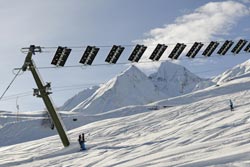The world’s first solar ski lift equipped with Siemens technology

The “Skilift Tenna” (GST) cooperative opted for technology from Siemens’ Industry Automation Division to modernize its drag-lift.
Since its commissioning in late 2011, the solar ski lift has produced three times more solar power than that required to operate it and has doubled the number of people it can transport.
The 460 meter long drag-lift is located at an altitude of 1644 meters in the holiday resort of Tenna and required refurbishing after 40 years in operation. To achieve this, GST opted for a combination of a photovoltaic system and automation.
The newly installed photovoltaic equipment associated with the drag-lift is based on a solar wing system, whereby 82 photovoltaic modules forming socalled solar wings are hung between two ropes and automatically track the position of the sun.
The system produces a total power of about 90,000 kWh per year, two-thirds of which are fed back into grid at market prices, using Sinvert PVM string inverters.
The draglift’s operation involves a significant number automation components. A Simatic S7 programmable logic controller, enhanced with a fail-safe CPU and ET 200S modules, control the ski lift‘s operation. The refurbishment made it possible to double the hourly transport capacity to 800 persons.
The exchange of data between the lift’s mountain and valley stations is also based on Siemens technology, using an IM 151-3 interface module from the ET 200S distributed peripherals range.
The entire ski lift system in Tenna is operated using a Simatic Touch Panel.
Media Contact
All latest news from the category: Power and Electrical Engineering
This topic covers issues related to energy generation, conversion, transportation and consumption and how the industry is addressing the challenge of energy efficiency in general.
innovations-report provides in-depth and informative reports and articles on subjects ranging from wind energy, fuel cell technology, solar energy, geothermal energy, petroleum, gas, nuclear engineering, alternative energy and energy efficiency to fusion, hydrogen and superconductor technologies.
Newest articles

A universal framework for spatial biology
SpatialData is a freely accessible tool to unify and integrate data from different omics technologies accounting for spatial information, which can provide holistic insights into health and disease. Biological processes…

How complex biological processes arise
A $20 million grant from the U.S. National Science Foundation (NSF) will support the establishment and operation of the National Synthesis Center for Emergence in the Molecular and Cellular Sciences (NCEMS) at…

Airborne single-photon lidar system achieves high-resolution 3D imaging
Compact, low-power system opens doors for photon-efficient drone and satellite-based environmental monitoring and mapping. Researchers have developed a compact and lightweight single-photon airborne lidar system that can acquire high-resolution 3D…





















